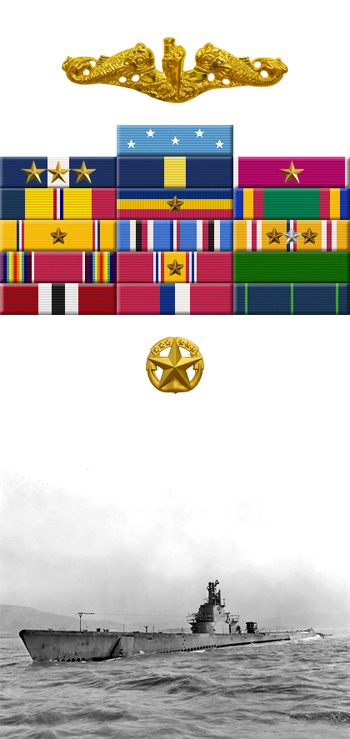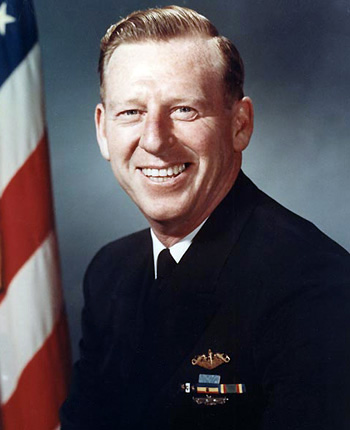
|
Eugene B. Fluckey |
 |
|||
| Rank, Service | ||||
Rear Admiral O-8, U.S. Navy |
||||
| Veteran of: | ||||
|
||||
| Tribute: | ||||
Eugene Fluckey was born on October 5, 1913, in Washington, D.C. He entered the U.S. Naval Academy on June 13, 1931, and was commissioned an Ensign on June 6, 1935. His first assignment was aboard the battleship USS Nevada (BB-36) from June 1935 to May 1936, followed by service aboard the destroyer USS McCormick (DD-223) from May 1936 to June 1938. He attended the Submarine School at Submarine Base New London, Connecticut, from June to December 1938, and then served aboard the submarine USS S-42 (SS-153) from December 1938 to June 1941. LT Fluckey served on the submarine USS Bonita (SS-165) from June 1941 to June 1942, making five war patrols during the opening months of World War II. He attended the U.S. Naval Academy's Postgraduate School from June 1942 to December 1943, and then attended the Prospective Commanding Officer's School at New London from December 1943 to January 1944. CDR Fluckey served as commanding officer of the submarine USS Barb (SS-220) from January 1944 to August 1945, and during this time he was credited with the most tonnage sunk by a U.S. skipper during World War II. His next assignment was on the staff of the Commander of Submarine Training Command, Pacific Fleet, from August to September 1945, followed by service as commanding officer of the submarine USS Dogfish (SS-350) during its fitting out from September to November 1945. He served as personal aide to the Chief of Naval Operations from November 1945 to June 1947, and then served as commanding officer of the submarine USS Halfbeak (SS-352) from June 1947 to May 1948. CDR Fluckey was aide to the Commander of Submarine Force, Atlantic Fleet, from May 1948 to July 1950, and he then served as U.S. Naval Attache and U.S. Naval Attache for Air in LIsbon, Portugal, from August 1950 to July 1953. CAPT Fluckey served as commander of Submarine Division FIFTY-TWO from August 1953 to June 1954, followed by service as commanding officer of the submarine tender USS Sperry (AS-12) from June 1954 to July 1955. He commanded Submarine Squadron FIVE from July to October 1955, and then served as commander of Submarine Group, Western Pacific, from October 1955 to January 1956. CAPT Fluckey briefly returned to Submarine Squadron FIVE as its commander from January to August 1956, and then served as the Head of the Department of Electrical Engineering at the U.S. Naval Academy from August 1956 to July 1958. He attended National War College from July 1958 to June 1959, and then served on the staff of the National Security Council in the Office of the Secretary of Defense from June 1959 to September 1960. ADM Fluckey was commander of Amphibious Group FOUR from September 1960 to November 1961, and then served as President of the Navy Board of Inspection and Survey from November 1961 to June 1964. His next assignment was as commander of the Submarine Force, Pacific Fleet, from June 1964 to June 1966, followed by service as Director of Naval Intelligence from July 1966 to June 1968. ADM Fluckey's final assignment was as Chief of the U.S. Military Assistance Advisory Group to Portugal from July 1968 until his retirement from the Navy on August 1, 1972. Eugene Fluckey died on June 28, 2007, and was buried at the U.S. Naval Academy Cemetery in Annapolis, Maryland. |
||||
|
||||

